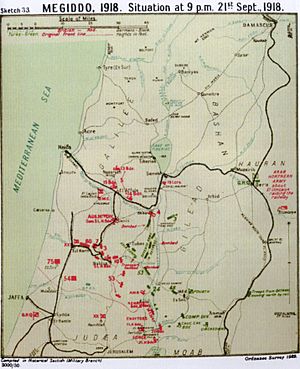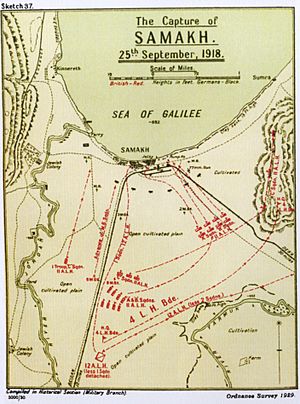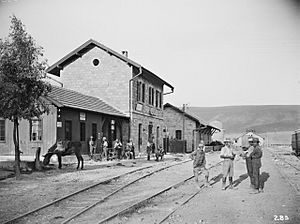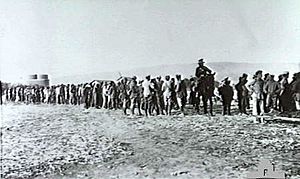Battle of Samakh facts for kids
Quick facts for kids Battle of Samakh |
|||||||
|---|---|---|---|---|---|---|---|
| Part of the Middle Eastern theatre of World War I | |||||||
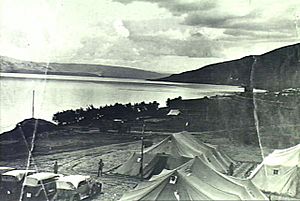 German Headquarters, Samakh |
|||||||
|
|||||||
| Belligerents | |||||||
|
|||||||
| Commanders and leaders | |||||||
| Units involved | |||||||
| Australian Mounted Division 4th Light Horse Brigade's Headquarters 11th Light Horse Regiment 12th Light Horse Regiment 4th Machine Gun Squadron |
Yildirim Army Group remnants from the Seventh Army Eighth Army formed into rearguard |
||||||
| Casualties and losses | |||||||
| 17 killed, 60 wounded, 1 missing | 98 killed, 33 wounded, 331 unwounded prisoners | ||||||
The Battle of Samakh was an important fight during World War I. It happened on September 25, 1918, in a place called Samakh near the Sea of Galilee. This battle was part of a bigger plan called the Battle of Megiddo, which helped end the war in the Middle East.
During this time, the Australian Light Horse soldiers, who were part of the Desert Mounted Corps, moved quickly behind enemy lines. They captured important areas like the Esdraelon Plain, also known as the Jezreel Valley. Samakh was a key location because it was part of a defensive line for the Ottoman and German forces. Their goal was to slow down the advancing British Empire troops.
The German commander, Otto Liman von Sanders, ordered his soldiers in Samakh to fight to the very end. The Australian 4th Light Horse Brigade attacked Samakh at dawn. The battle was intense, with close-up fighting in the village and especially at the railway station. After a tough fight, the Australians won, opening the way for the Allies to advance towards Damascus.
Contents
Why Samakh Was Important
After earlier attacks in 1918, the British commander, Edmund Allenby, wanted to extend the front line. Many British soldiers had been sent to the Western Front in Europe. They were replaced by soldiers from the British India Army. These new troops trained and prepared for a major attack.
On September 19, 1918, the British forces broke through the Ottoman lines. This allowed the Desert Mounted Corps, led by Harry Chauvel, to move quickly. They almost surrounded the Ottoman armies in the Judean Hills. They captured important towns like Nazareth, Haifa, and Afulah.
Samakh was a very important spot for both sides. It controlled a direct road to Damascus, which was a major supply route for the Ottomans. It also had railway lines that crossed the Jordan River. The German commander, Liman von Sanders, saw Samakh as a vital link in his defense. He reinforced the town with German machine gunners and told them to hold it at all costs.
Getting Ready for Battle

Some German and Ottoman soldiers, known as the Asia Corps, tried to retreat towards Beisan. However, Beisan was already captured by the Desert Mounted Corps. They then tried to reach Samakh, but were ordered to cross the Jordan River instead. This weakened the defenses at Samakh.
Meanwhile, the Australian Mounted Division was ordered to capture Samakh. This was part of the plan to secure the area and prepare for the advance to Damascus. The 4th Light Horse Brigade was chosen for the attack. They had limited troops available, but their commander, Brigadier General William Grant, decided to attack immediately. He didn't want to wait for more troops, as that would mean attacking in daylight.
The Battle Begins
The 4th Light Horse Brigade started their attack at 2:30 AM on September 25. They wanted to reach Samakh before dawn. The 11th Light Horse Regiment led the charge from the southeast.
As they galloped forward in the dark, they were met with heavy gunfire. The Ottoman and German soldiers were well hidden. The Australians had to change their plan and charge straight on. They used their machine guns to fire at the enemy's gun flashes.
The Australian squadrons managed to enter the village. The 12th Light Horse Regiment also moved in from the west to support them. The charge was difficult because the ground was uneven and covered with thorny plants. Several soldiers were injured from falls during the charge. This was a very unusual cavalry charge because it happened in the dark without much scouting beforehand.
Fighting in the Village
Once the Australian soldiers reached the town, they got off their horses and fought on foot. The railway station building was a strong stone structure, like a small fort. The defenders fired from its windows and threw grenades.
At one point, some white flags were seen, but when the Australians approached, they were fired upon. This led to many Australian casualties. The fighting inside the station was fierce, with soldiers using rifles, bayonets, and swords in close combat. They fought from room to room. Other enemy soldiers were hiding in the trains parked nearby, and they were also attacked.
The intense fighting at the railway station lasted for over an hour. More than 20 German and Ottoman soldiers were killed there. At the same time, other Australian squadrons moved into the rest of Samakh village and captured it with less resistance.
Results of the Battle
The Battle of Samakh was a clear victory for the Australian Light Horse.
- The Ottoman and German forces lost 98 soldiers killed and 33 wounded.
- The Australians captured 331 unwounded prisoners.
- They also captured one field gun, seven heavy machine guns, and many rifles and ammunition.
- Two locomotives, eight carriages, and an aircraft were also captured.
- The Australian forces had 17 soldiers killed, 60 wounded, and one missing. They also lost 77 horses.
After the Battle
After the battle, the 4th Light Horse Brigade buried their dead and cared for the wounded. A squadron from the 12th Light Horse Regiment moved along the western shore of the Sea of Galilee. They met with the 3rd Light Horse Brigade, which had captured Jenin and then Tiberias.
The capture of Samakh was the final part of the Battles of Megiddo. It meant that the Desert Mounted Corps had secured key areas like Haifa, Nazareth, and Tiberias. Two Ottoman armies were defeated, and the remaining Ottoman forces were retreating towards Damascus. General Allenby praised the Desert Mounted Corps for their "complete victory." This battle was unique and showed a new way of fighting that was very effective.
On September 27, the 4th Light Horse Brigade left Samakh and headed towards Damascus. The 15th Light Horse Regiment stayed to guard Samakh until other Indian troops arrived.
Remembering the Battle
The bravery of the soldiers who fought in these battles is remembered today.
- In 2017, the Beersheba ANZAC Memorial Center opened in Israel. It marked 100 years since the Battle of Beersheba. The event included a reenactment with horsemen, some of whom were descendants of the original soldiers.
- In 2019, a sculpture called 'The Aborigine and His Horse' was placed at Tzemach (near Samakh). It honors Aboriginal members of the ANZAC forces who fought there. Descendants of these Aboriginal horsemen traveled from Australia for the ceremony.


